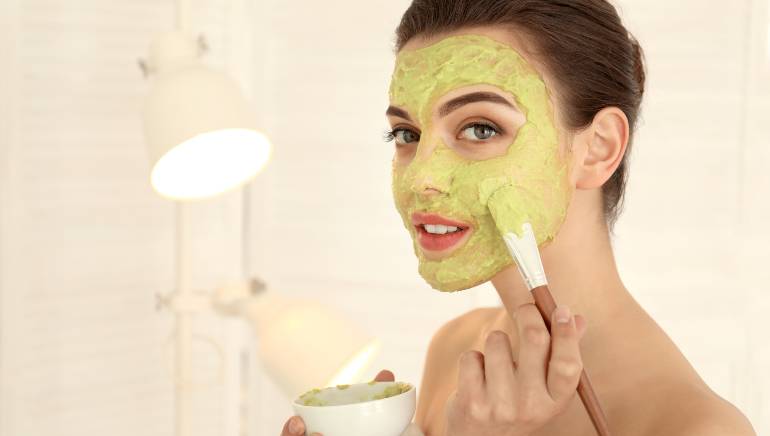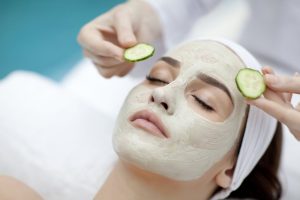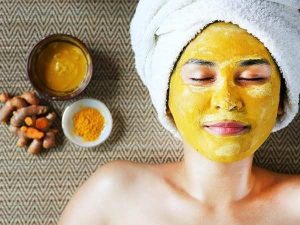7 Easy Home Remedies for Acne- Get Rid Pimples

Is your kitchen concealing the key to cleaner skin? Homemade acne remedies based on foods such as honey, cucumbers, and grapes may be used in conjunction with professional dermatological therapy.
Acne may be tenacious and appears at inconvenient times. The good news is that over-the-counter and prescription drugs can effectively treat pimples and help prevent future outbreaks. The bad news is that certain acne products may cause redness, discoloration, or dryness, according to the Mayo Clinic. (1) As a result, some people opt to treat acne at home using natural remedies.
Generally, the milder the acne, the easier it is to cure at home, according to Joshua Zeichner, MD, head of cosmetic and clinical research in dermatology at New York City’s Mount Sinai Hospital. However, in more severe situations — particularly when cysts or nodules are present — expert treatment is frequently required.
For mild acne, you may be shocked to discover that you already have various acne cures in your house – and conveniently, in your kitchen.
You may build an acne cure by combining popular foods and products, such as cucumbers, oats, grapes, and yeast, in a face mask. A DIY facial may aid in the prevention or resolution of acne, as well as maintaining beautiful, hydrated, and healthy skin.
- Grapes Purifier
Grapes are a pleasant snack that may be eaten simple, half as a salad topper, or frozen for a nutritious dessert. However, grapes are unlikely to spring to mind while considering acne remedies.
Nonetheless, research article published in April 2016 in Advances in Dermatology and Allergology indicates that resveratrol found in the skin of red grapes may have bactericidal effect against Cutibacterium acnes. C. acnes, formerly known as Propionibacterium acnes, is a bacteria that lives in the sebaceous glands and leads to acne. (2)
Therefore, take a couple fresh grapes from your refrigerator and you’ll have a simple facial cleanser. Cut two or three grapes in halves and massage the flesh over your face and neck, recommends dermatologist Fran E. Cook-Bolden, MD, director of Skin Specialty Dermatology in New York City. After that, rinse with cold water.

- Cucumber Mask For The Face
If you’ve ever visited a spa, you’ve probably had cucumber slices applied to your eyes to decrease puffiness – and it’s possible that this was not a fake treatment.
Cucumbers may have a calming impact on the skin, lowering inflammation, edoema, and soreness, according to a previous review. (3) As a result, they may be able to alleviate inflammation linked with acne.
Dr. Zeichner notes that in the case of acne, “inflammation occurs within the oil gland and follicle, resulting in red, angry pimples on the skin.” When acne spreads deep into the skin, “a cyst may form and fill with oil. When the cyst wall ruptures and the oil is exposed to the deeper layers of the skin, a strong inflammatory response frequently develops,” he explains.
Cucumbers can assist in several ways.
“Cucumbers have soothing and moisturizing properties for the skin, so if your skin is irritated from acne, cucumbers may have a little relaxing effect,” Zeichner explains. However, he cautions that they are ineffective in treating the underlying acne.
How to reap the rewards: “Blend together one small cucumber and one cup of oats to make a paste,” Dr. Cook-Bolden suggests. 1 teaspoon [tsp] of this mixture combined with 1 teaspoon [tsp] yoghurt and applied to the face. Allow 30 minutes before rinsing.
- Pack of Cucumbers for the Face
If you do not have oats or yogurt on hand, substitute this cucumber cure. This cooling, soothing mask will assist in smoothing your acne-prone skin. “Mash one entire cucumber, drain the water, and add 1 tablespoon sugar,” Cook-Bolden suggests. “Apply to your face and let on for ten minutes; then rinse well with cold water.”
- Uncomplicated Honey Mask
Honey possesses a plethora of medicinal benefits. The Mayo Clinic reports that some individuals use it as a natural cough syrup and to soothe a sore throat. (4)
According to an August 2016 paper published in the Central Asian Journal of Global Health, in vitro research indicate that honey’s antibacterial capabilities may help enhance wound healing and limit the growth of C. acnes. (5)
Rinse your skin with warm water before using this mask, Cook-Bolden advises. Then apply the honey to the skin and leave it on for 30 minutes. Warm water should be used to rinse the honey.
- Mask of Yeast and Yogurt for Oily Skin
Although further study is necessary, data published in April 2015 in the International Journal of Women’s Dermatology indicated that fermented dairy products such as yogurt may benefit skin health. Yogurt is also a probiotic, which has been demonstrated to suppress the growth of Propionibacterium acnes. (6)
To produce the mask, combine 1 tsp brewer’s yeast and a little amount of plain yogurt to form a thin paste. According to Cook-Bolden, “It should be applied liberally to all greasy areas and left on for 15 to 20 minutes. After rinsing with warm water, apply cold water to seal the pores.”
- Facial with Oatmeal
According to study published in January 2015 in the Journal of Drugs and Dermatology, oatmeal’s anti-inflammatory characteristics are naturally calming and may help reduce irritation caused by dermatological diseases such as rashes, erythema, burns, itching, and eczema. (7)
According to Zeichner, oatmeal improves the skin by protecting it, moisturizing it, and acting as an anti-inflammatory. “While it is not a cure-all for acne, it can help relieve dry, irritated skin. I frequently offer oat-based moisturizers to my patients who are on potentially unpleasant acne medications,” he adds.
2 tbsp oatmeal, 1 tbsp baking soda, and enough water to make a paste Spread the paste evenly on your face and gently massage it in. Following that, thoroughly rinse.

- Turmeric Mask for the Face
Brides in India usually apply a turmeric mask before their wedding to achieve flawless skin, according to Cook-Bolden. This is likely due to the spice’s anti-inflammatory, antimicrobial, and antioxidant properties, as well as its ability to significantly improve the severity of skin conditions such as acne, alopecia, atopic dermatitis, oral lichen planus, pruritus, and psoriasis, according to a review published in Phytotherapy Research in August 2016. (8)
Spice markets and ethnic food stores carry the ingredients for this acne treatment.
Combine 1/2 cup chickpea flour, 2 teaspoons turmeric powder, 2 teaspoons sandalwood powder, and 2 teaspoons ghee (clarified butter) or almond oil with enough water to produce a paste. “Apply and leave on for five to ten minutes,” Cook-Bolden advises. “Using both palms and fingers, rub vigorously to remove all the goo.” Rinse well with water.
A Final Word on Acne-Related Home Remedies
Homemade face masks can revitalize your skin and aid in acne clearing — and each of these recipes uses products that are likely already in your kitchen or refrigerator. Examine your skin’s response to one or more of these solutions for acne-prone skin.
If at-home therapies do not work after two to four weeks, consult a dermatologist, Zeichner advises. “Unfortunately, postponing treatment increases the chance of acquiring skin discoloration or, in rare situations, permanent scarring,” he cautions.







